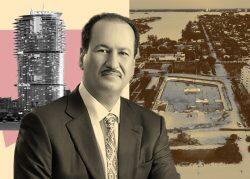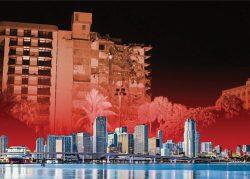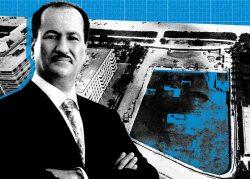Susie Rodriguez has difficulty accepting that a new building will soon stand in place of her former home, Champlain Towers South, which collapsed a year ago, killing her friends and neighbors.
“It will be very strange to see another building there,” said Rodriguez, who was not in her condo during the tragic event last summer. “I don’t think I can ever drive by Surfside and look at some other building.”
Rodriguez is among the survivors grappling with the loss of their homes, as well as mourning those who died. In the year since the collapse in the early morning of June 24 that killed 98 people, its effects have reached far across South Florida.
Read more



Developers, on the hunt for prime sites, have aggressively targeted buyouts of older properties. Florida lawmakers finally passed condo safety reforms, while local governments imposed more stringent inspection requirements. And the collapse site is in contract to sell to a new-to-market developer that plans a luxury condo building on the oceanfront 2-acre property.
Damac’s grand entrance
The court-appointed receiver for the Champlain condo association entered into a deal last fall to sell the site at 8777 Collins Avenue to Damac Properties, a Dubai-based developer hungry for a piece of South Florida real estate. Damac, led by billionaire founder Hussain Sajwani, was the sole bidder for the property, as local developers – the likes of the Related Group, Terra and Fortune International Group – and even builders across the country, steered clear of the bidding.
“We’re all fighting for great waterfront sites, but none of the small or large developers participated in this,” said Edgardo Defortuna, president of the brokerage and development firm Fortune.
While foreigners or those removed from the collapse “might have a different perspective, it’s something I’d rather stay away from, regardless of the potential income generation,” he said.
Damac is expected to close on the $120 million all-cash purchase later this summer. Based on the price for the land, asking prices for units at the Damac project could start at about $4.5 million, said former Surfside Vice Mayor and commissioner Dan Gielchinsky.
Founded in 2002 and primarily focused on developing in the Middle East, Damac plans to build a Cavalli-branded condo building on the property to mark its U.S. debut. Although the developer hasn’t disclosed further details on its plans, it will likely build large, luxurious units intended to appeal to foreign buyers purchasing second, third or fourth homes, experts speculate.
It may not exactly be a tough sell, as South Florida real estate has long catered to wealthy foreign buyers looking to park their cash.
“Your buyer profile is someone who does not live in the U.S.,” Gielchinsky said. “And memories are short. If people want high-end product and they make something nice, I think they will have little trouble selling units. I don’t think people are going to say, ‘I don’t want to live there.’”
The pending sale to Damac marks one of the final steps, as litigation over the collapse draws to a close. In court on Thursday, Judge Michael Hanzman approved the $1.02 billion class action settlement and the termination of the condominium (a technical process required for Damac to close on the land). The judge, attorneys, survivors and those who lost loved ones spoke about the year-long effort to settle the lawsuit.
“I feared I would spend the next decade mired in court proceedings,” said Eileen Rosenberg, whose daughter, Malky Weisz, died in the collapse. Thanking the judge for pushing for a quick resolution to the case, Rosenberg also shared her ongoing pain in losing her daughter. “My aching heart is shattered into a million pieces and beyond repair,” she said. “Although I am physically here, I died along with my Malky.”
To mark a year since the collapse, families of those who died will hold a private vigil early Friday morning at the site and light a commemorative torch that will remain lit for three weeks, or the time it took to recover the last victim.
It will be one of several events planned, including a 10 a.m. public memorial event Friday also at the collapse site.
Collapse was a “catalyst” for change
In May, Florida lawmakers passed legislation that eliminates the ability of associations to waive reserve requirements, institutes 30-year inspections of condo buildings three stories or taller, or 25 years if within three miles of the coast, and requires associations to conduct reserve studies with structural components. Every decade after the initial inspections, associations will be required to go through another recertification process. The law also opens liability to condo boards and their members if they fail to comply.
“The liability this bill forces on boards of directors and associations will cause more of those self-managed associations to seek out professional firms,” said Doug Weinstein, vice president of operations at AKAM Property Management.
Weinstein called the law a great start that puts “real pressure” on associations to complete repair and restoration projects on time.
The legislation and push to force building owners to maintain their properties makes condo living less affordable, as associations raise their monthly dues or issue special assessments to pay for repairs and restoration projects that may have otherwise gotten indefinitely postponed.
Before the statewide reforms passed last month, only buildings in Broward and Miami-Dade counties, as well as in Boca Raton, had recertification requirements. Many communities would defer major projects.
“These massive restorations have a huge financial impact even with financing programs,” said Jonathan Weislow, vice president of business development at Amicon Management.
The collapse shifted priorities for condo owners and associations. “The conversations used to center around getting the cheapest contractor. Now it’s about getting the best, most capable contractor with the right team,” Weislow said, adding that prior to the collapse, “people used to assume a building was safe.”
Municipalities have also enacted their own ordinances. In Miami-Dade, homeowners associations will be required to file structural reports, financial statements, insurance policies, budgets, and major planned projects by February of next year, and continue to do so on an annual basis. The county would then publish the information in a public database.
“The legislation has been a long time coming,” Weislow said. “What happened in Surfside was unfortunately a catalyst for these changes.”
Surfside embraces development
Surfside, a little-known town of less than 6,000 residents that was thrust in the international spotlight following the collapse, is now again largely off the radar. In March, residents voted out elected officials that held office at the time of the collapse, in favor of a new pro-development mayor and commission.
Armed with a new ordinance aimed at making construction safer, including for older buildings, the officials approved condo projects near the Champlain site. Other projects are also already planned.
Yet, concerns over safety remain rampant. Some neighbors have raised issues with new construction next door. A resident at one building in Surfside recently sued the town over its approval of a project next door that the resident claims could endanger her and her neighbors.
For decades, the half-mile-square town has imposed height and density limits to prevent it from becoming like its neighbors to the north — the high-rise mecca Sunny Isles Beach — and south — the cosmopolitan Miami Beach.
In March, Surfside voters approved a referendum that determines how oceanfront developable lots are measured to ensure uniformity in height and less density, though that will likely not have a major impact on the Champlain site redevelopment, which allows for up to 139 units and a building of up to 120 feet in height.
This year, the commission unanimously approved two new Fort Partners projects. Fort Partners, the developer of the Four Seasons Hotel and Residences at The Surf Club, has remained bullish on Surfside. It’s buying the site immediately south, at 8995 Collins Avenue, where the town approved plans for an 11-story, 19-unit development. Fort is also building the Seaway Villas project north of the Four Seasons. (The neighboring resident who is suing the town over the approval of the Seaway project is concerned that construction is damaging her building.)
In the end, the potential effect of new construction on adjacent buildings, as well as other structural and geological issues, are specific to each site, experts say.
“Everyone needs to learn from Surfside and begin to be proactive about how our buildings are constructed, what kind of maintenance have we done, are we doing the right kind of inspection?” said Randall Parkinson, a Florida International University research associate professor. “I think it’s important to know that not everyone is at the same risk. Everybody is not Surfside.”
